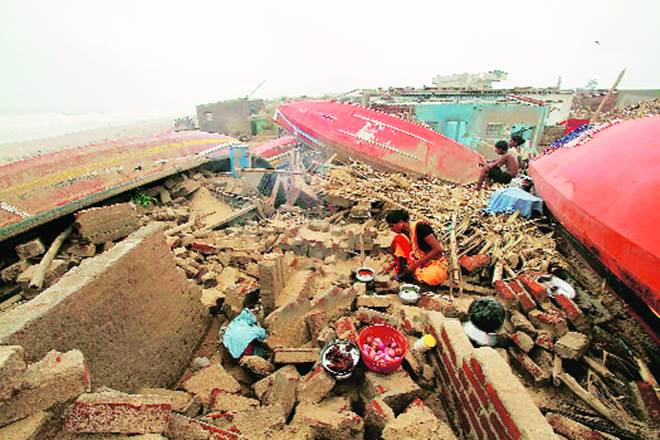The supercyclone Fani, with wind speeds of 220-250 km per hour, on May 3, 2019, had a devastating effect on the coastal districts of Odisha, one of the most cyclone- and flood-prone areas of India. The extent of the damage is much more than what was previously thought. The awareness and previous experiences of Odisha in dealing with natural disasters prompted the state government and people to move to safer areas, and this minimised loss of lives. However, the loss of infrastructure, basic public services, and loss to private property and livelihood are irreparable in the short-term.
Odisha, particularly its coastal districts, is prone to a huge number of cyclones and storms. Apart from small and moderate cyclones and storms, Odisha has suffered colossal damages during a supercyclone and flood in 1999, killing more than 10,000 people, Phailin in 2013, Titli in 2018, etc. In fact, every big natural disaster takes back the people and affected areas by few years in terms of the standard of living and the level of development, putting lot of stress on both the people and the state.
This time, Fani—said to be India’s strongest cyclone in 43 years—caused huge destruction. Going by the reported figures, almost 1.4 crore people in 11 coastal districts—of the total 4.2 crore people (2011 census) in Odisha—are badly affected, around 40 people have lost their lives so far, and about 5 lakh people have lost their houses. The infrastructure, livestock, properties, crops, coconut trees and horticulture have been destroyed completely, especially in Puri, Khordha and Bhubaneswar. The entire plantation developed over decades—source of livelihood—has been uprooted. As reported, around 4,600 buildings, 6,000 educational institutions such as primarily schools, 1,000 health facilities, and over 300 factories have been badly damaged. Further, 5,030 km of 33 kV lines, and 38,613 km of 11 kV lines, 11,077 distribution transformers, and 80,000 km of low tension distribution lines are also damaged. People have been deprived of clean water since May 3 due to damage to the water supply infrastructure and lack of electricity. The lifeline of the people, i.e. water, electricity and telecommunication, were taken away by Fani.
Given the extent of the damage, the support and relief provided so far has been largely inadequate. Odisha needs billions of dollars ($14 billion, as reported by the state government) to rebuild damaged houses and public infrastructure. Odisha sought help of Rs 17,000 crore (Rs 10,000 crore for disaster-resilient power infrastructure, and Rs 7,000 crore for converting 5 lakh damaged kutcha houses to pucca) from the Centre on May 6. The Centre has offered Rs 1,000 crore interim funding, in addition to the Rs 341 crore advance given before Fani. The Centre has announced an amount of Rs 2 lakh ex gratia to each family of those killed, and Rs 50,000 to the injured. In addition, some states have given few crores as financial assistance and provided manpower support to restore power. However, the relief support in terms of resources and manpower is grossly inadequate, given the colossal loss in terms of livelihood and infrastructure. The support of international agencies is lukewarm, except a loud appreciation to the state government in minimising human losses.
It’s sad to observe that the coverage in the national media about the extent of the damage appears under-reported. In fact, the air time on the Fani was much more before the landfall. International media has given a one-liner thumbs up, stating that the Odisha government has done an excellent job. Unfortunately, it gives an impression of little damage whereas it needs to be categorised as a national disaster. The expected material support in terms of materials and resources from central and state governments, international agencies, the general public and the private sector is not forthcoming. Lakhs of families need housing with electricity and water connection. Since Fani, people are literally in the dark, without water and telecom services. What Odisha needs now is huge resources and manpower to bring about some semblance of normalcy by providing basic lifesaving services, not an appreciation certificate for minimising human loss. Being in a federation, people affected by the ruthless Fani have a right to get appropriate support from the central government as well as other states to restore life in affected areas.
Given the extent of the damage and livelihood loss, a one-time meagre compensation in terms of a few thousands of rupees for housing or a few kilos of rice is not of great use. All affected coastal districts need immediate special package from the Centre to restore housing, power, water supply and road network. There should be measures like farm-loan waiver and credit opportunities as crops have been destroyed and people have lost income-generating assets and avenues.
Apart from these short-term measures, the Centre and states have to seriously work on cyclone-resilient infrastructure like underground power supply, cyclone-resilient housing, enhancing disaster management personnel and infrastructure, restoring plantation, all-weather and well-established communication network, prepare a 24/7 contingency plan, and enough government shelters and basic services such as food, water and medicines to meet any such kind of calamity. These are all the more necessary steps for a state like Odisha that is the most vulnerable to supercyclones and floods. Fani is not going to be the last, and people of Odisha deserve better support immediately and for future preparedness.


